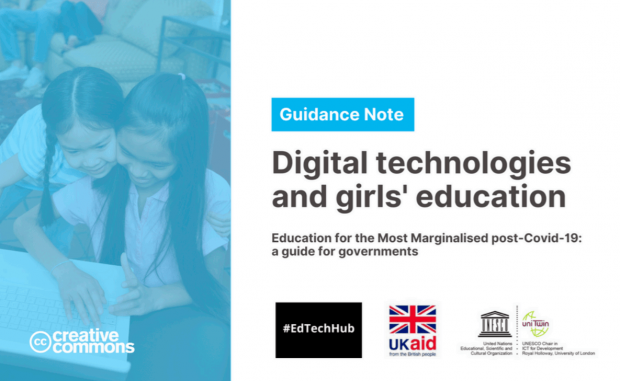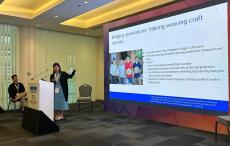2020 has been a year defined by the global response to the COVID-19 crisis. Over the past 12 months, the pandemic has had a particularly negative impact on some of the most marginalised communities. In our previous posts, we examined how the intersections of social, economic, education, and digital exclusion might influence girls. The COVID-19 crisis has brought about new challenges in the ways many girls access education, especially in the context of the sudden shift to remote-learning. Available data shows that in many developing countries, girls have less access to digital technologies in comparison to boys. The long-term impact of COVID-19 might lead to devastating consequences when it comes to girls’ individual self-determination, agency as well as the wider problem of gender inequality.
Looking into 2021, digital and tele-education are here to stay. Unfortunately, so is the problem of the gender digital divide. Considering the multi-layered nature, how can we ensure that any future developments using digital technologies in education consider and address girls’ needs in their design and implementation? What considerations should be addressed by the global policymakers in their efforts to equitably implement digital technologies in education in the post-pandemic world?
These questions were central to the recent EdTech Hub’s publication led by Professor Tim Unwin, the UNESCO Chair in ICT for Development and Chair of UNU Macau’s Advisory Board. The report, “Education for the most marginalised post‑COVID‑19: Guidance for governments on the use of digital technologies in education”, was also co-authored by Dr Alicja Pawluczuk, Young ICTD Fellow at the United Nations University Institute in Macau (other authors include Azra Naseem, Mohamed Shareef, Paul Spiesberger, Paul West, and Christopher Yoo).
The report provides recommendations to governments on how to use digital technologies in the COVID-19 era and beyond, “to deliver better quality and more resilient education systems that enable everyone to have access to equitable learning opportunities”. To achieve this, the report offers a set of 14 guidance notes for the governments. All guidance notes are informed by the outcomes of #EMMpostcovid19 consultations.
To consider the problem of girls’ unequal access to digital technologies and education, the report offers a set of guidance notes, “Guidance Note 3: “Digital technologies and girls’ education” (lead authors Alicja Pawluczuk, Juliette Unwin, Paul Spiesberger, and Tim Unwin).
Below we outline the steps (as published in the report) that governments can take to reduce gender digital inequalities in learning through digital technologies.
-
Governments should ensure that girls have as equal access to digital technologies(both devices and content) as do boys throughout the education system.
-
Governments should ensure that there is appropriate legislation, enforcement and guidance to help protect girls and women from all forms of abuse, bullying and harassment through digital technologies. Clear guidance should also be provided in locally relevant languages and images for girls about the safe use of digital technologies.
-
Governments should focus explicitly on culturally specific ways through which they can empower girls to become informed and proactive agents of future social and technological change.
-
Governments should ensure that they collect gender-disaggregated data with respect to digital technologies so that they can accurately monitor changes in gender digital inequality.
-
Governments should ensure that they put in place effective initiatives to change men’s attitudes towards women and digital technologies; emphasis should not be placed simply on providing programmes to support girls and women in technology.
-
Governments should encourage education to be seen as a collective and networked experience, in which learners, parents, guardians, educators and facilitators all have important roles to play, and all of whom require appropriate digital access and skills training (see also Guidance Note 14 on partnerships).
-
Be careful and selective in choosing the most relevant and appropriate digital ‘solutions’ for girls. There are very many organisations offering digital ‘solutions’ for girls’ education, and great care is needed in selecting those that are most relevant and appropriate for girls and women in your own context.
-
Examples of successful women should be used appropriately in all educational content. Women scientists, for example, should be shown as often as men scientists in textbooks and online content.
#EMMpostcovid19 report emphasizes the importance of taking a holistic and pro-active approach in our efforts to achieve equitable education for all. To ensure that no one is left behind in the post-covid19 world, governments need to examine how and if their educational solutions sever the most marginalised. As illustrated in the report, any efforts to develop sustainable digital solutions in education for girls’ (and other marginalised groups), should be reviewed in the contexts of the existing infrastructures, pedagogies, and socio-economic norms. Such analysis should also consider the importance of ethical and safe use of digital technologies in education.
To learn more about the report and to read the other #EMMpostcovid19 guidance notes, please visit the EdTech Hub page.
Suggested citation: Alicja Pawluczuk., "Digital Technologies and Girls’ Education: #EMMpostcovid19 Guidance for Governments on the Use of Digital Technologies in Education," UNU Macau (blog), 2021-01-05, https://unu.edu/macau/blog-post/digital-technologies-and-girls-education-emmpostcovid19-guidance-governments-use.



